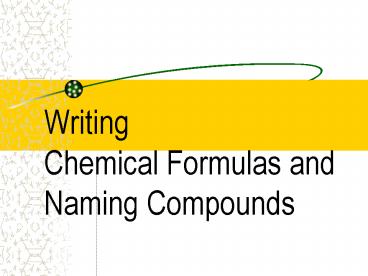Writing Chemical Formulas and Naming Compounds - PowerPoint PPT Presentation
1 / 23
Title:
Writing Chemical Formulas and Naming Compounds
Description:
Negative ions (anions) drop the ending of the name and add the suffix ide. ... Titanium (IV) sulfide. D. Iron (II) oxide. Polyatomic Ions ... – PowerPoint PPT presentation
Number of Views:4119
Avg rating:3.0/5.0
Title: Writing Chemical Formulas and Naming Compounds
1
Writing Chemical Formulas and Naming Compounds
2
Ions and charges
- Main groups on the periodic table
- Positive ions (cations) name of element
followed by the word ion - Negative ions (anions) drop the ending of the
name and add the suffix ide. Then add the word
ion. - Symbols for ions symbol for the element
followed by a superscript showing the charge.
3
1. Write the symbol for the following ions
- a. Nitride ion
- b. Fluoride ion
- c. Magnesium ion
- d. Hydrogen ion
4
2. Write the name for the following ions
- a. Na
- b. Sr2
- c. S-2
- d. Br
5
Naming binary ionic compounds
- The positive ion (cation) is always the first one
in the chemical formula. - Write the name of the positive element
- Then write the name of the negative ion (drop the
ending and add ide) - For example sodium chloride
6
Write the name for the following binary ionic
compounds
- A. LiCl
- B. Na2O
- C. CaS
- D. MgF2
7
Writing the formulas forbinary ionic compounds
- Write the symbols with the charges
- Figure out how many atoms of each ion would be
needed to balance the overall charge to zero - Use subscripts to show how many atoms of each ion
are necessary
8
4. Write the formula for the following binary
ionic compounds.
- A. Lithium oxide
- B. Sodium fluoride
- C. Potassium chloride
- D. Magnesium sulfide
9
Naming binary molecular compounds
- Use prefixes to tell how many atoms of each
element are needed - 1 mono-
- 2 di-
- 3 tri-
- 4 tetra-
- 5 penta-
- 6 hexa-
- 7 hepta-
10
Naming binary molecular compounds
- For the first element in the formula
- No prefix is used if there is only one atom
- If the element starts with a vowel, and the
prefix ends with an a, drop the letter a from
the end of the prefix - For the second element in the formula,
- Always use a prefix
- If the element starts with a vowel, and the
prefix ends with an a, drop the letter a from
the end of the prefix
11
5. Write the name of the following binary
molecular compounds
- A. CS2
- B. SO3
- C. N2O3
- D. Si3N4
12
Writing formulas for binary molecular
compounds
- Use the prefixes to determine the number of atoms
of each element (NOT THE CHARGE). - 1 mono-
- 2 di-
- 3 tri-
- 4 tetra-
- 5 penta-
- 6 hexa-
- 7 hepta-
13
Write the formulas for the following binary
molecular compounds
- A. dihydrogen monoxide
- B. carbon tetrafluoride
- C. dinitrogen pentoxide
- D. phosphorus trichloride
14
Stock System of Nomenclature
- A naming system used to name compounds that uses
Roman Numerals to represent the positive
oxidation state (relative charge) of an element
when it has more than one oxidation state.
15
Stock System of Nomenclature naming compounds
- Write the name of the first element
- Check the periodic table to see if it has more
than one positive oxidation state - If it does, use a roman numeral in parenthesis to
show the oxidation state then write the name of
the negative part (drop the ending and add ide) - If it only has one oxidation state, then no roman
numeral is necessary. Just finish by writing the
name of the negative part (drop the ending and
add ide).
16
Name the following compounds using the stock
system of nomenclature
- A. CuCl2
- B. NiO
- C. Co2O3
- D. PCl3
17
Stock System of Nomenclature writing formulas
- Write the symbol for the first element
- Use the roman numeral to write the charge or
oxidation state of the element - Then write the symbol for the second part with
the negative charge (elements only ever have one
possible negative charge). - Balance the charges using subscripts just like
you did before.
18
8. Write the formulas for the following compounds.
- A. Chromium (III) chloride
- B. Cobalt (II) oxide
- C. Titanium (IV) sulfide
- D. Iron (II) oxide
19
Polyatomic Ions
- Groups of covalently bonded atoms with a charge
- You need to memorize ten polyatomic ions
- Treated as a single unit in compounds
- NaOH sodium hydroxide
- Fe2(SO4)3 Iron (III) sulfate
20
POLYATOMIC IONS to memorize
Ammonium NH4 1 Nitrate NO3 1 Nitrite NO2
1 Sulfate SO4 2 Sulfite SO3 -2
Carbonate CO3 2 Bicarbonate HCO3
1 Phosphate PO4 3 Phosphite PO3
3 Acetate C2H302 -1
21
Naming and Formulas with polyatomic ions
- Use the same rules as ionic compounds and the
stock system of nomenclature
22
9. Name these compounds using the stock system of
nomenclature.
- A. NH4Cl
- B. CuSO4
- C. Ca(NO3)2
- D. Na3PO4
23
10. Write the formula for these compounds using
the stock system of nomenclature
- A. Ammonium chloride
- B. Copper (II) sulfate
- C. Iron (III) sulfite
- D. Ammonium phosphate































